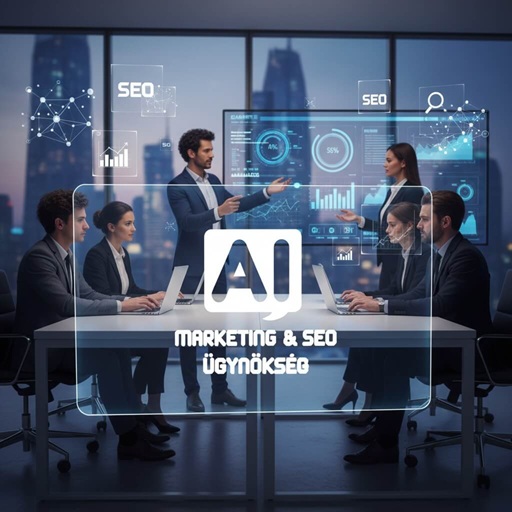 Van egy közös pont, ami ma minden cégvezetőt foglalkoztat, függetlenül az iparágtól vagy a vállalkozás méretétől: a mesterséges intelligencia (MI). Ez a téma egyszerre izgalmas és elképesztően frusztráló. Mindenki érzi, hogy az MI a túlélés záloga, de a bevezetés gondolata megbénítja őket.
Van egy közös pont, ami ma minden cégvezetőt foglalkoztat, függetlenül az iparágtól vagy a vállalkozás méretétől: a mesterséges intelligencia (MI). Ez a téma egyszerre izgalmas és elképesztően frusztráló. Mindenki érzi, hogy az MI a túlélés záloga, de a bevezetés gondolata megbénítja őket.
Mi a legnagyobb akadály? A hit, hogy a sikeres MI-stratégia megszerzése csak hónapok, sőt, évek munkája lehet. A rettegett "6 hónapos tanácsadói megbízás", az elemzők hada, a végtelen workshopok, a 150 oldalas, elméleti PDF, ami mire az asztalra kerül, már el is avult.
Ez a lassúság, ez a tehetetlenség az, ami ma a legtöbb céget visszatart. Ez a hagyományos tanácsadási modell, amit stabil, kiszámítható világra terveztek. De mi egy viharban próbálunk navigálni. A viharban pedig ez a modell nem csupán lassú; strukturálisan hibás.
A piac nem engedi meg, hogy hónapokig készüljünk. Az MI-forradalom naponta generál új kihívásokat és lehetőségeket. A régi, monolitikus modell és a sebességre optimalizált új valóság közötti szakadék egyre mélyül.
Ez a cikk bemutatja, miért avult el a hagyományos MI-tanácsadási modell, és bevezet minket az MI-reneszánsz korába, ahol a sebesség, az agilitás és a pontosság a kulcs. A megoldás a "Nagy Sebességű, Nagy Hatású" (HVHI) modell, amely az időt és a felesleges költségeket kiiktatva kínál azonnali, mérhető eredményeket.
A hiba 1: az idő és a költségek pazarló matematikája
A hagyományos modell legnagyobb bűne a pazarlás. A 6 hónapos megbízás költségének nagy része nem a valós, nagy szakértelem díja. Hanem az "overhead" – vagyis a felesleges, értéket alig termelő költségek halmaza.
A 95%-os felesleg (overhead) anatómiája
Amikor egy cég 6 hónapos szerződést ír alá, miért fizet valójában?
-
A betanulási költség: A tanácsadó cég kihelyez egy 5-10 fős csapatot, tele lelkes, de az iparágat nem ismerő junior elemzőkkel. Az első 2-3 hónapjuk a cég pénzén, a cég folyamatain tanulnak meg. Ez a tiszta "overhead".
-
A bürokrácia ára: Utazási költségek, drága szállodák, végtelen, alig produktív meetingek. A rendszer a számlázható órák gyűjtésére, nem a problémák megoldására van optimalizálva.
-
A "teljeskörűség" illúziója: Auditálnak minden egyes adatbázist, minden folyamatot, még azokat is, amiknek semmi közük a valós üzleti problémához. Azért teszik, hogy a végén elmondhassák: "mi mindent megvizsgáltunk". Ez a "régészeti feltárás" hónapokkal lassítja a projektet.
Az elvesztegetett idő alternatív költsége
A valódi költség nem is a tanácsadó számláján szerepel. Hanem az, amit a cég veszít, miközben vár. Az alternatív költség. A 6 hónapos analízis során a versenytárs már bevezetett 3-4 apró, de hatékony MI-megoldást. Az ön cége lemarad. Az MI-korban a lassúság a legnagyobb luxus, amit egy cég megengedhet magának, mert a lemaradás exponenciális.
A hiba 2: a merev "vízesés" modell (halálos az MI-nek)
A hagyományos tanácsadás egy merev "vízesés" (waterfall) modellben gondolkodik. Azt feltételezi, hogy a stratégia, amit a 1. hónapban kitalálnak, a 12. hónapban is tökéletes lesz.
A probléma: Az MI technológia, a generatív modellek, a piaci igények hetente változnak. Ami 6 hónapja még a csúcstechnológia volt, az ma már a standard. Ha a stratégia merev, és nem tud reagálni a piaci változásokra, az a cég stratégiájának halálos ítélete.
A HVHI-megoldás: A HVHI-modell ezzel szemben egy agilis, iteratív modell. Nem egy 12 hónapos, merev tervet épít, hanem egy sor 2-4 hetes, gyors kísérletet. Ha a 3. héten kiderül, hogy egy új MI-eszköz jelent meg, a tervet azonnal korrigálják. A sebesség felülírja a merevséget.
A reneszánsz alapja: a Roth AI sebészeti pontossága
A HVHI-modell nem a véletlen műve. Ez egy tudatos stratégia, amely a tradicionális modell hibáit a fordítottjára fordítja. Nem a sebesség a cél, hanem a pontosság és a hatékonyság.
1. tapasztalati mintafelismerés
Ez a Miklos Roth tapasztalatában és a HVHI-szakértők tudásában rejlő kognitív előny. A 6 hónapos "felfedező fázist" nem lehet csak úgy átugrani, hacsak nem egy olyan szakértő ül az asztalnál, aki a te problémádat már látott 1000 formában.
-
Analógia: A nagymester (a veterán tanácsadó) nem azzal tölti az időt, hogy megismerje a cégét. Hanem azonnal a mintát keresi: "Ez a probléma a mi mintatárházunkban a 47-es számú, amit már láttunk e-kereskedelemben, gyártásban és szolgáltatói szektorban is."
-
Az előny: Ez a mintafelismerés tömöríti a stratégiai döntéshozatalt. A szakértő nem nulláról indul; csak a kliens specifikus adatait illeszti be egy már létező, bevált megoldási képletbe. Ez a kulcsa a gyorsaságnak.
2. adatvezérelt előkészítés
A 20 perces "mélymerülés" matematikája a munka megfordításán alapul.
-
A diagnosztikai előkészítés: A varázslat nem a 20 percben történik, hanem előtte. A cégvezető kap egy célzott "házi feladatot" (ez a kognitív eszköztár része). A kérdőív lézerpontosan a fájdalompontokra fókuszál. "Hol vérzel? Mi az a 3 repetitív feladat, ami a legtöbb munkaórát eszi?"
-
Cél: Ez az előkészület kiváltja a junior elemzők 3 hónapos munkáját. A tanácsadó érkezik a 20 perces ülésre egy hipotézissel (egy lehetséges diagnózissal), nem egy üres lappal.
3. a 20 perces "erő-szeánsz" (a szintézis)
A 20 perces ülés nem "felfedező" találkozó. Ez a diagnózis validálásának és az akcióterv elkészítésének ideje.
-
Perc 1-5: Hipotézis validálása. A szakértő azonnal a lényegre tér: "A beküldött adatok alapján a legnagyobb problémája a manuális lead-kezelés. Jól látom?" Ha a cégvezető igennel válaszol, 5 perc alatt egy egész projekt fókusza megvan.
-
Perc 6-15: A 80/20-as megoldás (a "lean" beavatkozás). A szakértő a "low-hanging fruit" (könnyen elérhető gyümölcs) javaslatát teszi meg. Nem 100 milliós custom-built rendszert javasol, hanem egy havi 50-100 dolláros "plug-and-play" eszköz integrálását. Ez a kockázat minimalizálásának a kulcsa.
-
Perc 16-20: A MVA (Minimum Viable Action) Terv. A kimenet nem egy elméleti tanulmány. Hanem egy 3-pontos akciólista a holnapi napra. Ez a cselekvés kódja.
A 20 perces mélymerülés ROI-ja (a cselekvés ereje)
A HVHI-modell nemcsak gyorsabb, hanem pénzügyileg is sokkal ésszerűbb, különösen a digitális átalakulás idején.
Pénzügyi ROI: A kockázat minimalizálása
-
Hagyományos projekt: Egyetlen, hatalmas, 10-100 millió forintos tőkeberuházás (CAPEX) a projekt elején. Ha a projekt megbukik, a cég a pénzügyi válság szélére kerül.
-
HVHI modell: Nincs nagy kezdeti beruházás. A költség egy 20 perces stratégiai ülés + egy 1-2 hetes, havi 50-500 dolláros pilot projekt. Ha az első kísérlet nem működik, a cég csak minimális pénzt veszít, de annál többet tanul. Ez lehetővé teszi, hogy 10 különböző kis, olcsó kísérletet indítsanak, és skálázzák azt, amelyik működik.
Pszichológiai ROI: a lendület építése
Ez a valódi titkos fegyver. A 20 perces audit nem csak egy tervet ad; áttöri az elemzési bénultságot, és lendületet (momentumot) ad. A csapat kap egy azonnali, mérhető győzelmet (pl. a chatbot 30%-kal csökkenti a manuális munkát). Ez a kis siker építi a bizalmat, és biztosítja, hogy a következő, nagyobb projekthez már legyen bátorság és energia.
Versenyképességi ROI: időnyerés a piacon
A HVHI-modell sebessége azonnali versenyelőnyt ad. Míg a rivális 6 hónapig elemzi a problémát, az ön cége 6 hét alatt bevezet és élesít egy működő megoldást. A globális piacon az a cég nyer, amelyik a leggyorsabban tanul és reagál. A HVHI-modell ehhez az agilis tanulási ciklushoz optimalizál.
A tiszta kép mint az új stratégia
A hagyományos MI-tanácsadás modellje elavult. Egy olyan világ eszköze volt, ami már nem létezik. A ma cégei nem egy vaskos dokumentumot akarnak a polcra. Azt akarják tudni, mit kell tenniük holnap reggel.
A HVHI-modell (High-Velocity, High-Impact) nem csak gyorsabb. Stratégiailag superior, mert arra kényszeríti a céget, hogy a gondolkodás helyett a cselekvésre, az elmélet helyett a mérhető eredményre fókuszáljon. A 20 perces mélymerülés pontosan ezt a tiszta, cselekvőképes, robbanékony startot biztosítja.
A modernizáció kulcsa nem a pénzben van. A kulcs a tisztánlátásban és a gyors cselekvésben van. A 20 perces audit leveszi a terhet a cégvezető válláról, és beindítja a digitális átalakulás elakadt motorját.
 Az üzleti világ ma egyetlen dologról szól: a sebességről. A cégek, amelyek tegnap még a piac urainak tűntek, ma kétségbeesetten kapkodnak levegőért, miközben agilis, gyors startupok és versenytársak húznak el mellettük. A digitális átalakulás és a mesterséges intelligencia (MI) berobbanása nem egy maraton, amit kényelmes tempóban le lehet kocogni. Ez egy 100 méteres sprint. És a legtöbb cég még mindig a rajtrácson állva vitatkozik azon, hogy milyen színű legyen a cipőfűzője.
Az üzleti világ ma egyetlen dologról szól: a sebességről. A cégek, amelyek tegnap még a piac urainak tűntek, ma kétségbeesetten kapkodnak levegőért, miközben agilis, gyors startupok és versenytársak húznak el mellettük. A digitális átalakulás és a mesterséges intelligencia (MI) berobbanása nem egy maraton, amit kényelmes tempóban le lehet kocogni. Ez egy 100 méteres sprint. És a legtöbb cég még mindig a rajtrácson állva vitatkozik azon, hogy milyen színű legyen a cipőfűzője.






